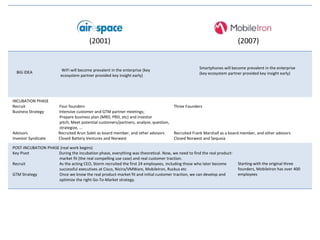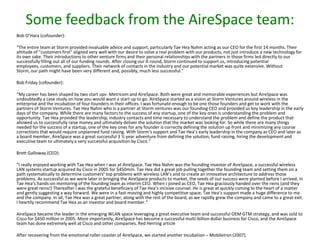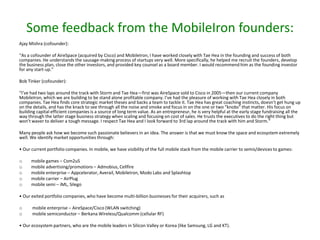Storm's incubation strategy
- 1. Storm’s Incubation Strategy A key element of Storm’s strategy has been incubations. Sold to Cisco We believe that Storm’s incubation program is different from most others because of our focus on doing only a few quality incubations and our close involvement beyond just the incubation phase. To focus on quality, Storm does relatively few incubations concentrated in a specific theme. Before incubating, we ask ourselves this question: Is the idea so compelling that we would quit our job to be a cofounder? As former founders who worked for no salary, we understand the financial and emotional challenges of leaving a very successful job, especially with no safety net. So, if the idea is not that compelling, we will not incubate the idea. We usually test several ideas with our ecosystem and finalize on one idea after an intense period of extensive market interaction and deep strategic thinking, usually with the first founder. Once we become a true believer in the Big Idea, we can help recruit the rest of the founding team, introduce potential customers and Go-To-Market partners, and then help close the financing syndicate. We understand the incubation phase quite well after serving as the early CEO of AireSpace for a year. Notwithstanding the appeal of the original Big Idea, all our successful incubations (including AireSpace and MobileIron) made several critical, nonobvious strategic pivots after the incubation phase. As a result, we actually believe the incubation phase is the easiest part of a company’s life cycle. We believe that the company’s next phase is always harder – just like a baseball player moving from A to AA to AAA to the majors, and then the all-stars. So, Storm continues to work closely with the team and add value long after the early incubation – in contrast to most other incubation programs. Since each incubation is a huge time and emotional commitment, we incubate a company when we want to go very deep in the specific space, such as mobile. Since starting AireSpace in 2001, Storm has made over 20 mobile investments and three more mobile incubations: MobileIron (2007), Averail (2011) and AirPlug (2011). From the AireSpace experience, we have learned to look for founders (and co-investors and board members) who are more passionate about the idea than us, who are smarter than us, and who have the ability to execute and take the idea to the next level and beyond.
- 2. (2001) BIG IDEA INCUBATION PHASE Recruit Business Strategy Advisors Investor Syndicate WiFi will become prevalent in the enterprise (key ecosystem partner provided key insight early) Four founders Intensive customer and GTM partner meetings; Prepare business plan (MRD, PRD, etc) and investor pitch; Meet potential customers/partners, analyze, question, strategize, ... Recruited Arun Sobti as board member, and other advisors Closed Battery Ventures and Norwest (2007) Smartphones will become prevalent in the enterprise (key ecosystem partner provided key insight early) Three Founders Recruited Frank Marshall as a board member, and other advisors Closed Norwest and Sequoia POST-INCUBATION PHASE (real work begins) Key Pivot During the incubation phase, everything was theoretical. Now, we need to find the real productmarket fit (the real compelling use case) and real customer traction. Recruit As the acting CEO, Storm recruited the first 24 employees, including those who later become successful executives at Cisco, Nicira/VMWare, MobileIron, Ruckus etc GTM Strategy Once we know the real product-market fit and initial customer traction, we can develop and optimize the right Go-To-Market strategy. Starting with the original three founders, MobileIron has over 400 employees
- 3. Some feedback from the AireSpace team: Bob O’Hara (cofounder): “The entire team at Storm provided invaluable advice and support, particularly Tae Hea Nahm acting as our CEO for the first 14 months. Their attitude of “customers first” aligned very well with our desire to solve a real problem with our products, not just introduce a new technology for its own sake. Their introductions to other venture firms and their personal relationships with the partners in those firms led directly to our successfully filling out all of our funding rounds. After closing our A round, Storm continued to support us, introducing potential employees, customers, and suppliers. Their network of contacts in the industry and our potential market was quite extensive. Without Storm, our path might have been very different and, possibly, much less successful.” Bob Friday (cofounder): “My career has been shaped by two start ups- Metricom and AireSpace. Both were great and memorable experiences but AireSpace was undoubtedly a case study on how you would want a start up to go. AireSpace started as a vision at Storm Ventures around wireless in the enterprise and the incubation of four founders in their offices. I was fortunate enough to be one those founders and get to work with the partners of Storm Ventures. Tae Hea Nahm who is a partner at Storm ventures was our founding CEO and provided us key leadership in the early days of the company. While there are many factors to the success of any startup, one of the key ones is understanding the problem and opportunity. Tae Hea provided the leadership, industry contacts and time necessary to understand the problem and define the product that allowed us to successfully raise money and ultimately deliver the solution that the market was looking for. So while there are many things needed for the success of a startup, one of the key ones for any founder is correctly defining the solution up front and minimizing any course corrections that would require unplanned fund raising. With Storm’s support and Tae Hea’s early leadership in the company as CEO and later as a board member, AireSpace was a great successful 3 ½ year adventure from defining the solution, fund raising, hiring the development and executive team to ultimately a very successful acquisition by Cisco.” Brett Galloway (CEO): “I really enjoyed working with Tae Hea when I was at AireSpace. Tae Hea Nahm was the founding investor of AireSpace, a successful wireless LAN systems startup acquired by Cisco in 2005 for $450mm. Tae Hea did a great job pulling together the founding team and setting them on a path systematically to determine customers’ top problems with wireless LAN’s and to create an innovative architecture to address those problems. As successful as we were later in bringing the AireSpace products to market, the seeds of our success were planted before I arrived, in Tae Hea’s hands-on mentoring of the founding team as interim CEO. When I joined as CEO, Tae Hea graciously handed over the reins (and they were great reins!) Thereafter I was the grateful beneficiary of Tae Hea’s incisive counsel. He is great at quickly coming to the heart of a matter and gently suggesting a way forward. We were in a fast-moving and highly competitive space; Tae Hea’s support made a huge difference to me and the company. In all, Tae Hea was a great partner, along with the rest of the board, as we rapidly grew the company and came to a great exit. I heartily recommend Tae Hea as an investor and board member.” AireSpace became the leader in the emerging WLAN space leveraging a great executive team and successful OEM GTM strategy, and was sold to Cisco for $450 million in 2005. More importantly, AireSpace has become a successful multi-billion dollar business for Cisco, and the AireSpace team has done extremely well at Cisco and other companies. Red Herring article After recovering from the emotional roller coaster of AireSpace, we started another incubation – MobileIron (2007).
- 4. Some feedback from the MobileIron founders: Ajay Mishra (cofounder): “As a cofounder of AireSpace (acquired by Cisco) and MobileIron, I have worked closely with Tae Hea in the founding and success of both companies. He understands the sausage-making process of startups very well. More specifically, he helped me recruit the founders, develop the business plan, close the other investors, and provided key counsel as a board member. I would recommend him as the founding investor for any start-up.” Bob Tinker (cofounder): “I’ve had two laps around the track with Storm and Tae Hea—first was AireSpace sold to Cisco in 2005—then our current company MobileIron, which we are building to be stand alone profitable company. I’ve had the pleasure of working with Tae Hea closely in both companies. Tae Hea finds core strategic market theses and backs a team to tackle it. Tae Hea has great coaching instincts, doesn’t get hung up on the details, and has the knack to see through all the noise and smoke and focus in on the one or two “knobs” that matter. His focus on building capital efficient companies is a source of long term value. As an entrepreneur, he is very helpful at the early stage fundraising all the way through the latter stage business strategy when scaling and focusing on cost of sales. He trusts the executives to do the right thing but won’t waver to deliver a tough message. I respect Tae Hea and I look forward to 3rd lap around the track with him and Storm.” Many people ask how we become such passionate believers in an idea. The answer is that we must know the space and ecosystem extremely well. We identify market opportunities through: • Our current portfolio companies. In mobile, we have visibility of the full mobile stack from the mobile carrier to semis/devices to games: o o o o o mobile games – Com2uS mobile advertising/promotions – Admobius, Cellfire mobile enterprise – Appcelerator, Averail, MobileIron, Modo Labs and Splashtop mobile carrier – AirPlug mobile semi – iML, Silego • Our exited portfolio companies, who have become multi-billion businesses for their acquirers, such as o o mobile enterprise – AireSpace/Cisco (WLAN switching) mobile semiconductor – Berkana Wireless/Qualcomm (cellular RF) • Our ecosystem partners, who are the mobile leaders in Silicon Valley or Korea (like Samsung, LG and KT).



